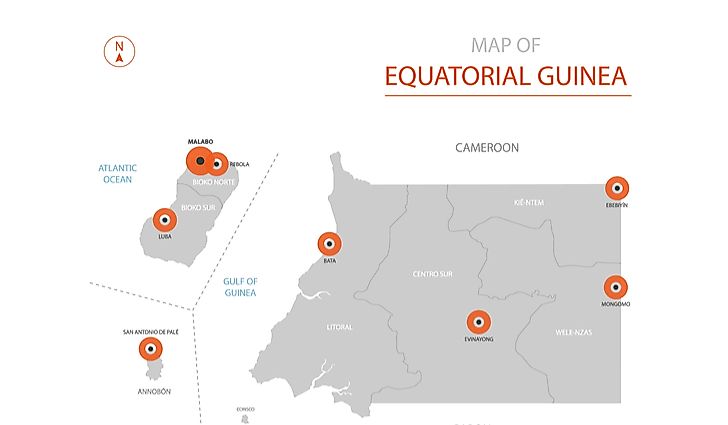Which Countries Border Equatorial Guinea?

Equatorial Guinea is a nation that covers an area of 11,000 square miles in the central region of Africa. Historically, Equatorial Guinea was been to home to different population groups, including pygmies, the Beti-Pahuin, and the Bubi. The boundaries of Equatorial Guinea have been shaped by periods of European colonization and interest from Portugal, Spain and Britain. Equatorial Guinea's current land borders stretch for a distance of approximately 328 miles and are shared with two nations: Cameroon and Gabon. The nation also has maritime boundaries which are shared with Sao Tome and Principe, and Nigeria.
The History of Equatorial Guinea's Borders
One event that shaped the boundaries of Equatorial Guinea was the signing of an agreement, the Treaty of El Pardo, by the monarchs of Spain and Portugal in 1778. Before the treaty was signed, Portugal had colonized two islands within the region, Fernando Pó and Annobón. The treaty gave Spain control over certain areas of land, although the territory was ultimately ruled by the Viceroyalty of the Río de la Plata in Buenos Aires. Although the treaty gave Spain access to land in the region, Spain failed to occupy much of it, which enabled France to expand its occupation in Central Africa. France and Spain later signed a treaty in 1900, the Treaty of Paris, which vastly reduced the amount of land under Spanish control in the contested region. Spain's portion of land would later become Equitorial Guinea, and historical records suggest that the territory was reduced by approximately 105,792 square miles. Spain's control of the region lasted until Equatorial Guinea gained its independence in 1968.
Cameroon
Equatorial Guinea's shortest land border is shared with Cameroon, which is roughly 113 miles long. The border is situated along the northern edge of Equatorial Guinea, and there are some important towns situated along the border. On the Cameroonian side, the principal town along the border is Ambam, which had a population of roughly 1,596 people according to 2005 estimates. On the Equatorial Guinean side, one of the most significant towns is Ayamiken.
Relationship Between Cameroon and Equatorial Guinea
Cameroon and Equatorial Guinea have close bilateral ties that date back to the colonial period. These ties have created a favorable environment for trade and migration, particularly of workers from one nation to the other. One reason that has contributed to the close bilateral ties between Cameroon and Equatorial Guinea is the fact that both nations are members of regional organizations such as the African Union (AU) and the African Development Bank Group (AfDB). Another factor is that Equatorial Guinea and Cameroon both have diplomatic missions within the other country's borders. In Equatorial Guinea, the Cameroonian government is represented by an embassy situated in Malabo, as well as a consulate located in Bata. In Cameroon, the government of Equatorial Guinea has three official representations: an embassy situated in the capital, Yaoundé; a consulate-general located in the town of Ebolowa; and a consulate situated in Douala.
Border Disputes
Despite the positive relationship between Cameroon and Equatorial Guinea, the two nations were recently engaged in a border dispute. The dispute began after soldiers from Equatorial Guinea killed a fisherman from Cameroon, and later abducted two Cameroonian nationals. The attacks greatly angered the Cameroonian government, which resulted in the closing of the border. The border was later reopened after the dispute had been resolved. In 2018, however, the border was closed again closed in response to fears by the government of Equatorial Guinea that Cameroonians would aid in a coup attempt against the president, Teodoro Obiang Nguema. In both instances, the border's closure had a significant impact on the local economy, primarily because traders were unable to sell goods or replenish stock. In 2018, the border was closed for roughly six months, and its reopening revitalized the local economy. The two nations also have a dispute regarding their maritime border, which is yet to be adequately defined.
Gabon
Equatorial Guinea's longest land border is shared with Gabon, which is roughly 214 miles long. Gabon bounds Equatorial Guinea to the south and east. The key feature that defines the border between the two nations is the island of Corisco, which encompasses an area of about 5 square miles.
Relationship Between Gabon and Equatorial Guinea
Gabon and Equatorial Guinea have a relatively good relationship due to their close diplomatic ties. In Gabon, the government of Equatorial Guinea is represented by an embassy situated in Libreville. In Equatorial Guinea, the government of Gabon is represented by an embassy located in Malabo.
Border Disputes
Despite close ties between the two nations, their relationship has been dramatically affected by a maritime border dispute. The maritime dispute arose because of the possibility of an oil discovery in Corisco Bay. The United Nations managed to convince the leaders of both countries to bring the issue to the International Court of Justice for deliberation.
Security Along National Borders
Security experts believe it is essential to safeguard a nation's borders for various reasons. One primary reason is to safeguard citizens from terrorists who could cause widespread destruction within a country. Another reason why borders should be kept secure is to protect local industries by preventing the market from being saturated with cheap products from other nations.











